Thirteen-year-old Bessie Bradwell staggered through the burning streets, her heart pounding in fear. All around her, flames shot hundreds of feet into the air. Glowing embers and hunks of burning wood rained down.
It was October 8, 1871, and the city of Chicago, Illinois, was on fire. Already hundreds of buildings had burned to the ground. Thousands of people filled the streets, their screams rising over the crackling roar.
In the panic and confusion, Bessie had lost track of her parents and brother. Now, facing one of the worst disasters in U.S. history, Bessie was on her own.
Thirteen-year-old Bessie Bradwell staggered through the burning streets. Her heart pounded in fear. All around her, flames shot hundreds of feet into the air. Glowing embers and hunks of burning wood rained down. It was October 8, 1871, and the city of Chicago, Illinois, was on fire. Already hundreds of buildings had burned to the ground. Thousands of people filled the streets, their screams rising over the crackling roar.
In the panic and confusion, Bessie had lost track of her parents and brother. Now, facing one of the worst disasters in U.S. history, Bessie was on her own.

